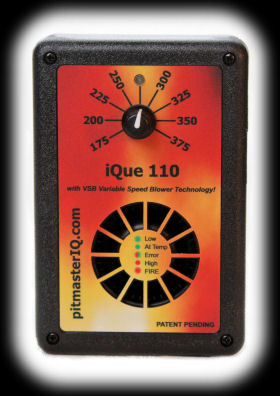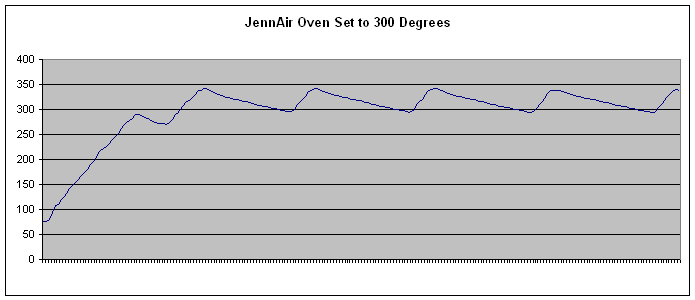 |
 |

Operating The iQue 110 Controller So, how does the iQue 110 controller perform in operation? The real test of any temperature controller is how it performs at low temperatures. The reason for this is that the device can only make the cooker hotter. The cooker has to cool off on its own, and a cooker is much more willing to cool off at 450 degrees than it is at 225 degrees. So, the controller has to be a little more subtle and clever to control the lower cooking temperatures so as not to get the fire so hot that the cooker can't cool off fast enough. The iQue 110 controller did a reasonably good job of controlling temps at low, medium and high temperatures, hitting the targets within few degrees or less and maintaining the targets within a reasonble range. And one last note before we show you the numbers. Since the iQue 110 does not have a temperature readout we measured the cooker's temperature by placing a Thermoworks THS-113-041 bare junction thermocouple about ¼-inch from the tip of the iQue 110 temperature probe and recorded values at 30-second intervals. (Normally, we use the temperature readout of the unit being tested.) Also, since this unit sets the target temperature using a dial versus a digital setting, we can't know exactly what the target temperature setting was. However, we placed the indicator on the dial as close to our target temperature as possible.
As you can see, the iQue 110 controller did a reasonable job at low, medium and high temperatures. When initially taking the cooker to the each temperature, there was a varying amount of initial overshoot, from 0 to 39 degrees, but the unit quickly settled into a cycle that was close to the target and gradually got closer as time went on. (We feel overshoot gets way too much attention, but readers want to know so we measure it. The cooker isn't over the target temperature long enough to really heat up the cooker itself, the temperature drops back down, so what's to worry about?) We did one other test involving an airflow restrictor (a washer, essentially) that comes with the unit. The washer can be inserted into the hose and held in the first ridge. We were warned that it might take several swear words to get the washer in place, but we managed without swearing as it was relatively easy to get the washer in place. The restrictor is provided for use with smaller cookers or super-insulated cookers where the blower might just be too much. We were advised that we should not need to use it on a large Big Green Egg cooker. We repeated the low temperature (225°) test with the washer in place. What we found was that the unit maintained a slightly lower temperature than without the washer, but had about the same amount of temperature swing with the washer in place. So, you would only want to try the washer if you found the unit constantly keeping the fire too hot. The iQue 110 did have a greater variation in temperature than we have observed with other controllers, but we would point out that this unit, like all units, provides a level of control which exceeds that which you might think necessary. Compare our results with the iQue 110 to your average kitchen oven, which is doing good if it keeps your oven within plus or minus 25 degrees. Even an expensive oven won't come close. We've said this many times, so we'll say it again and show you again how our $2000+ JennAir Dual Fuel Cooker performs when set to 300 degrees. (Since we paid $2000+ for this cooker, we're going to flog this chart for all it is worth.):

$2000 JennAir Temperature Control Results Essentially, our expensive cooker missed the target by 25° with a swing of 25° on either side. Not even close to what the iQue 110 can do. A few things we'll point out about using the iQue 110 controller:
Compared To The BBQ Guru NanoQ and Auber The following table shows you a comparison of the specifications and performance for the Auber Instruments controller versus the BBQ Guru NanoQ.
iQue 110, Auber Instruments or NanoQ? The obvious competitors to the iQue 110 controller are the BBQ Guru NanoQ and the Auber Instruments controller. All three models are low cost, and only control the temperature of your cooker. So which one should you choose? As usual, it all depends on what you want. With the NanoQ, you get rugged build, quality temperature probe cable, more blower choices, Open Lid Detect and automatic Adaptive Control. Of course, you pay more for all that. On the other hand with the Auber Insturments controller you get the ability to set a target temperature within 1 degree, a bright and VERY usable display, 2 audible alarms, and the ability to use about any thermocouple probe you wish. With the iQue 110, you get low price, all-in-one unit, simple operation, Platinum RTD probe, and the quick and easy-to-use dial method of selecting your target temperature. All three units are more than accurate enough to give you the kind of control you want for your cooker, so the choice really comes down the price and features of the units. The pitmasterIQ.com iQue 110 is a simple, easy-to-use, all-in-one temperature controller that comes at a very modest price. While it is not quite as accurate as other higher-priced models, it certainly does the job very well, and will keep your cooker on track while you are off doing other things like sleeping. We will definitely add this controller to our collection and use it when we just need temperature control.
pitmasterIQ.com (636) 447-7974
Web: www.pitmasterIQ.com | ||||||||||||||||||||||||||||||||||||||||||||||||||||||||||||||||||||||||||||||||||||||||||||||||||||||
You can support this website by shopping at The Naked Whiz Website Store and Amazon.com
|